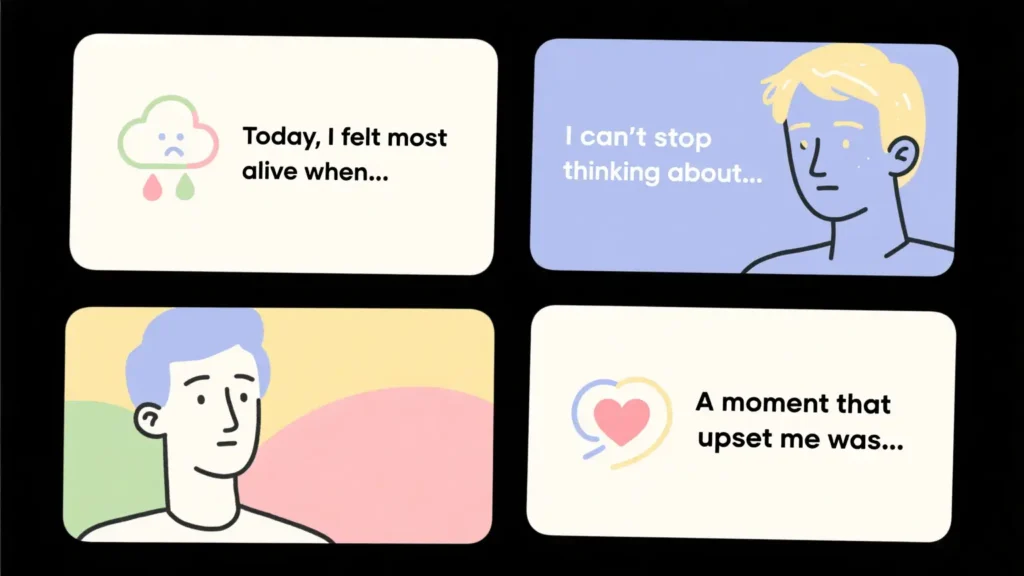In today’s time-critical and overly interconnected world, it can seem pretty hard to find a quiet moment and look deep inside. We all become too busy with the work-family-social-media triad that it is tough to realize the importance of pausing for yourself and getting stillness of mind while you are always surrounded by too much noise not only physically but also soulfully. We are sleepwalking and do not even stop to think about it.
This is the period in our life when we become addicted to the digital world at the expense of our own being, and that’s where journaling can help us so much it becomes a matter of life and death. We’ve got to bear in mind that, however old-fashioned it is, journaling is never old and unneeded. It’s a solution for today’s concerns!

In relation to this subject, we also mention “emotional journaling” as the core of the article. In usual cases, only teenagers and those in the creative world normally come into contact with such practice. Still, emotional journaling is a counseling practice that has been proved to be very effective through various psychological researches. It is an ideal way for people to express their feelings, reveal hidden things about themselves, and improve their emotional intelligence.
We have prepared an in-depth guide about emotional journaling, including the very beginning steps up to maintaining and developing your emotional growth. If you are looking for a deeper understanding of yourself or just feel overburdened, emotional journaling can change the world for you.
1. Why Emotional Journaling Matters
Explaining how the process works is the starting point, but it is also important for everyone to know the benefits of practicing such a thing. Emotional journaling is not only limited to the act of writing down your feelings. It is chiseling a path that connects your conscious mind with your emotional side.
Mental Health Benefits
Investigations indicate that expressive writing plays a major role in reducing stress, anxiety, and depressive symptoms. The studies conducted by Dr. James Pennebaker, who is a key figure in this field, showed that people who write about their innermost thoughts and feelings for no more than 15 minutes a day exhibit physical and mental health progress of significant scope.
Emotional Awareness
When you give a name to your emotions by converting them into words, you are compelling your brain to stop and identify accurately your emotions. This broadens your language of feelings and self-recognition, which are the bedrock of emotional regulation.
Problem Solving
Writing about a problem you are battling with most of the time provides a way for you to solve it and see it clearly. Expressive writing helps in the clarification of facts from feelings, old problem resolution with logic rather than panic is the end result, and it is emotionally managed painlessly thereby.
2. Choosing the Right Journal and Setup
The initiation of an emotional diary necessitates no advanced tools, but a proper surrounding can foster the experience significantly, therefore lead to more beneficial and fun results.
Paper vs. Digital
- Paper Journals: Give your writing a solid, stay focused, and provides a physical connection to your feelings and thoughts. Numerous people mention that the act of writing by hands leads them to the processing of thoughts more deeply.
- Digital Journals: Are easy to carry around, can be searched and are very personal. Programs like Day One, Notion, or Evernote allow you to write wherever you are and even insert voice memos or pictures.
Setting the Mood
The quiet space you pick for journaling ought to be serene. If possible do light a candle, brew a cup of your favorite tea, and choose a corner that’s noise-free. You would like your brain to learn and understand that this is your truth, discovery, and encouragement time.
Recommended Tools
- An empty notebook or a guided journal
- Pen or pencil
- Optional: Mood tracker apps, emotional wheel printouts
3. Newbie Emotional Journaling Techniques
There is no single method that can be termed as the right way to write an emotional journal but using certain methods can aid beginners in writing emotional journals comfortably.
Free Writing
Here one can set up an uninterrupted writing activity by selecting a time (usually 10-15 minutes) and just write. Let go of worries regarding grammar, spelling, or the structure of the text. Simply let the ideas come to your mind.

Prompt Writing
There are times when we need a push to get started. So, here are some prompts to choose from:
- “Today, I felt most alive when…”
- “I can’t stop thinking about…”
- “A moment that upset me this week was…”
- “Right now, I feel… because…”
Emotion Wheel Technique
The idea is to make use of a tool like the “emotion wheel” for recognizing and naming complex feelings. Begin with basic emotions (happy, sad, angry) and progress to the more specific ones (content, frustrated, insecure).
Gratitude Journaling
Although mainly a tool of positive psychology, gratitude journaling is a part of the picture of emotional writing. Being sure about what you thank the most can be a good balance when hacking negative thoughts.
4. Creating a Sustainable Habit
To start an emotional journal is one thing, but turning it into a habit is another challenge. Regularity is the main factor in reaping the benefits for a longer period of time.
Set a Time
Decide on one particular time of the day – in the morning, before bedtime, or during a lunch break. Eventually, your mind will get used to thinking that this is the time for processing your emotions.
When starting your journey to self-awareness through emotional journaling, it is not important to promise yourself to fill pages daily. Just a single sentence could be enough to express your feelings. In this case what you target is not the volume of your writing but the sincerity of your emotions.
Keep the Log on Track
Record your feelings every day by using a calendar, or a habit tracker. The graphics illustrating your progress will definitely inspire you.
Live By the “Don’t Skip Twice” Principle
If you didn’t write one day, that’s totally fine. But make sure you don’t do the same thing the next day.
5. What to Expect & Common Misconceptions
There are folks who have wrong expectations about emotional journaling. Below you will find the proper expectations:
It’s Not Always Glamorous
You can write lousy, meaningless, or totally raw entries. Affirmations are still just words. What is meaningful here is truth, not art.
It May Run Deeply & Bring Pain
No problem with that. This place is warm and welcoming to all your emotions. If you need to, cry, stun, squeal with joy. Healing is taking place.
It’s Not Guaranteed That You’re Always Ready to Talk
Start by talking about the sense of your body, or reveal the place where you are at the moment. Mainly, if you let your thoughts become vocal the emotions will come on their heels.
It’s Not a Miracle Cure
Emotional journaling desires a playful approach. If you expect to have all the answers when you write or immediately after, this isn’t the case. Benefits build up gradually.

6. Emotional Growth Through Time Reflection
To be able to recollect your thoughts and see your development is one of the most enriching benefits of emotional journaling.
Review Prior Writings
Plan to browse through the last several months of your diary once in a while. You may notice patterns in the things that upset you, how you dealt with them, and what changed over time.
Retrieve The Lessons
Use highlighting tools like markers or sticky notes to pick out your insights. In so doing you will be achieving two things at once – first, you are actively reminding yourself of the growth that took place, and second, you are getting to know your self more deeply.
Make Over Your Feelings
Can you resolve conflicts in a new way? Are you gentler towards yourself? The process of journaling might reveal a lot of hidden feelings and turn them into your own virtues for personal growth.
Make a Unique Collection from Previous Work
Put together the most effective short prose pieces or phrases into a small book. In case you face future troubles, it will serve as your “bag of feelings” to help overcome such difficulties.
One Thing to Keep in Mind: Your Story Counts
It will be enough to begin with an emotional journal to bring about the desired change. It’s not necessarily a tough process to carry out because it doesn’t have to be difficult if you are willing to be there for yourself with sincerity. Whether it’s dealing with grief, finding clarity, or simply being one with yourself again, journaling has it all covered—no public exposure, only personal nourishment.
Although we are always running and looking at our time clocks in order to grow our productivity, it is equally important to talk about emotional health and acknowledge its importance. In acknowledging your inner world, you are choosing to spend your energy effectually. And, this step is not at all hard, just take a paper and envelope, put aside your doubts, and write.
And with that one honest movement, you are already writing your success story. Your story really matters.
A Summary of Keywords Position:
- Wrote “how to start an emotional journal” 3x throughout the article
- Other related expressions like “emotional journaling,” “emotional growth,” “emotional writing,” and “mental clarity” appeared